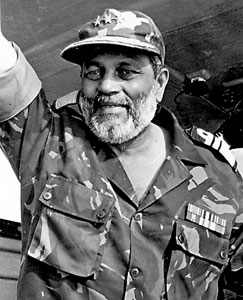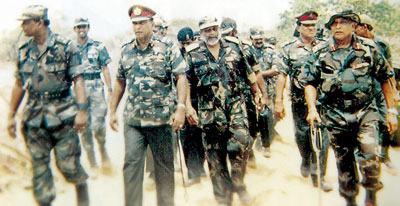He set the course for the Navy to battle the LTTE
View(s):Tribute | Rear Admiral (Dr.) Sarath Weerasekara – MP, remembers Admiral Clancy Fernando
“A leader has to be intelligent. But intellect alone is not sufficient. It is a dead thing unless and until it becomes illuminated by the influence of other qualities. Only when the intellect becomes illuminated by the vivifying influence of certain other qualities such as compassion, professionalism, and patriotism, etc that you get a good fully-fledged leader”.

Admiral Clancy Fernando visiting naval detachments in the Kilaly/Nagathivanthurai frontline area onboard a water-jet boat of the Sri Lanka Navy
This quote which I read somewhere has registered in my mind forever, and without exaggeration I must say that the calibre and character of Admiral Clancy Fernando, perfectly fitted the above definition of a “good and a fully fledged leader”.
Admiral Fernando was assassinated by an LTTE suicide bomber on November 16, 1992. I was at the Naval Headquarters and was one of the first officers to rush to the scene. A few minutes later, Mrs. Monica Fernando arrived. I had to hold her back and can still feel her grief and pain at the loss of her beloved husband. She is elegant-looking, well-mannered, with a genuine smile, and although 20 years have passed since then, I can still see a trace of pain hidden in her charming face.
Admiral Fernando was the most senior serving military officer to be felled in the line of duty in Sri Lanka and most probably the first serving Commander of the Navy in the world to be assassinated by a terrorist organisation. He had won hearts, through the many naval operations at sea, and at his funeral, when the ceremonial bugle sounded the “Last Post”, I can vividly remember how the eyes of his battle-hardened men glistened like shining medals.
Joining the Navy as an Officer Cadet on December 17, 1957, Admiral Fernando had his initial training at the Britannia Royal Naval College, Dartmouth. Being a professional from the very inception, he came up the ladder by following military courses in prestigious Naval Colleges around the world, passing exams and finally became the Commander of the Sri Lanka Navy on August 1, 1991. When he made his supreme sacrifice for the Motherland, he had been at the helm for just over one year, with a great portion of his strategic planning yet to be implemented. Today, we reflect on a great officer and pay tribute to his invaluable service rendered to our country during an exemplary career spanning 35 years.
Admiral Fernando was a specialist in naval communications. He contributed immensely in that field and his most praiseworthy and huge contribution towards efficient and secure communication was his introduction of our first ever cryptographic system “SINHALE” which replaced the Royal Navy’s “Britex” system which the Sri Lanka Navy had to follow since inception.
Always courteous, considerate and tolerant, he always believed in and embodied that well known phrase “officer and a gentleman”. He wrote a book on “Customs and Etiquettes of the Services” which has become a handbook for all the officers.
Admiral Fernando was a historian and always liked to probe into history. His book on naval battles off Trincomalee describing the Portuguese, Dutch, French and British naval battles and the ships sunk was one of the finest and most interesting I have ever come across. His enthusiasm towards tracing the history of naval guns and cannons have encouraged his subordinates to follow suit and paved the way for the establishment of the Naval Museum at the Trincomalee Naval Dockyard. Although the Admiral is no more with us, it is a pleasure to notice that his elder son Nishan, obviously inspired by his father from childhood, is keen on Naval history and continues to embody his father’s endeavours in that regard.
What was the reason for the terrorists to plan to assassinate Admiral Fernando at any cost? Was it because he was just another Service Commander? No. The actual reason was because Admiral Fernando was gradually becoming a dangerous threat to the LTTE, the most ruthless terrorist organization in the world.
The LTTE was trying to dominate the sea and lagoons so that they could easily bring in their supplies and also engage in cross-border terrorism. They also established camps along the coastline to launch Sea Tiger attacks against naval vessels operating in the northern seas.

Operation Balavegaya: Marching to the Elephant Pass camp along with General Waidyaratne, General Kobbekaduwa and Brigadier Wimalaratna
Admiral Fernando, applying the principle of critical thinking, developed a coherent strategy which was almost foolproof and result-oriented. One fine example was when the naval ships did not possess big calibre long-range guns for Naval Gun Fire Support (NGFS) in order to soften the beach or deter the enemy, Admiral Fernando planned and took the most challenging task of loading a MBT (Main Battle Tank) on to a LCM (Landing Craft Medium). The tank was secured firmly on the deck against the roll and pitch of the craft and the MBT was used for NGFS. It proved a resounding success and was obviously a morale booster to the Navy and the Army.
Admiral Fernando always believed in mutual “understanding and mutual cooperation” amongst tri-services when it came to National Security. His contribution to tri-service operations on land and sea was invaluable and he always accommodated Army and Air Force operational and logistical-related requirements, without any questions.
It was Admiral Fernando who introduced the concept of small boat operations in the Navy by adding less expensive, locally-made Inshore Patrol Craft (IPC) and water jets to our fleet to operate in shallow waters, especially the lagoons. The LTTE’s main activities were across the Kilali Lagoon and Admiral Fernando’s vision made him to establish two strategically-located naval detachments at Pooneryn and Nagathevanthurai.
These two naval detachments, by using IPC’s and water jets with 12.7 guns fitted fore and aft, completely took the enemy by surprise and totally dominated the lagoon and successfully cut off the main supply route of the LTTE to their great frustration. This concept of “Small Boat Operations” was further improved and developed by subsequent Commanders culminating in the present day Rapid Action Boat Squadron which played a key role in dealing with LTTE suicide boats in the open sea. Hence, the small boat operation of the Navy certainly was the brainchild of Admiral Clancy Fernando.
The Palk Bay and the northern sea, as always, has been a haven for Indian fishing trawlers. They come not in tens but in hundreds and whilst they raped our sea bed, the LTTE utilised a few of them to smuggle their weapons, ammunition, explosives and even men. Admiral Fernando maintained that supplies reaching the LTTE from South India could be stopped to a great extent if the Indian trawlers poaching in our water could be minimized. He then, with the permission of the government, went to South India and called on the Chief Minister of Tamil Nadu, Jayalalitha Jeyaram and expressed Sri Lanka’s security concerns about the Indian trawler excursions into our territorial waters. The combined operations of the Indian Coast Guard ships and Sri Lanka Naval ships to prevent fishing vessels crossing each country’s border was the subsequent ultimate result of the initiative taken by Admiral Fernando during his short tenure.
It is thus very clearly understood as to why the LTTE was desperate to destroy this intelligent and valiant officer whose strategic plans, if allowed to be implemented fully, were definitely going to be highly detrimental to their mere existence let alone offensive ops. Hence Admiral Fernando had to pay with his life, and make the supreme sacrifice for becoming a highly dangerous and formidable threat to terrorists. With his demise we lost a true patriot, a great officer and a gentleman and a valuable son of Mother Lanka. Although he faded away beneath the waves, the inspiration, initiative and the leadership he had given, made the Navy continue to steer the course he set, with guns ablaze, and ultimately wipe out the terrorist Sea Tiger fleet from the Indian Ocean and contribute towards the great victory achieved by the forces under the leadership of the present Secretary of Defence and the President.
May he attain Nibbana.
Follow @timesonlinelk
comments powered by Disqus

















